Unit III
Dividend Policies
Dividend policy issues
Companies typically use dividend policies to maximize the value of their investment, pursuing the goal of maximizing shareholder returns. Shareholder returns consist of dividends and capital gains. Dividend policy has a direct impact on these two components of revenue. Even if the dividend is not declared and is reserved by the company, the wealth and profits of shareholders will increase.
Consider different ratios that affect our dividend policy.
1. Payment ratio
It is defined as a dividend as a percentage of revenue. It is an important concept of dividend policy. Companies may decide to share almost all of their revenue. Another company may decide to distribute only a portion of its revenue. It may appear at first, but the previous company declares the maximum dividend. But in the long run, the latter company, which declares only a portion of its revenue, could overtake its former high-paying companies.
Let us now look at this with an example.
Firms X and Y have equity capital of Rs.100. Let us assume both the firms generate 25% earnings every year. Let us assume that Firm X declares 50% dividend every year and firm Y declares only 25% dividend every year.
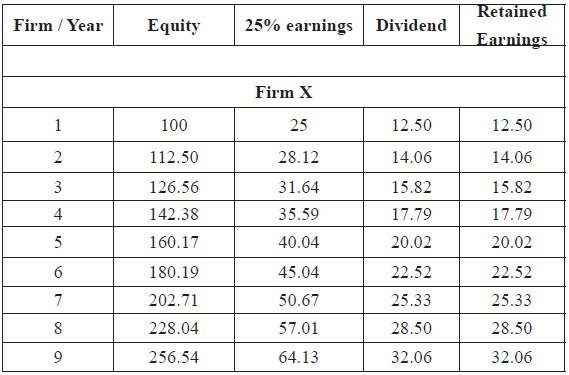
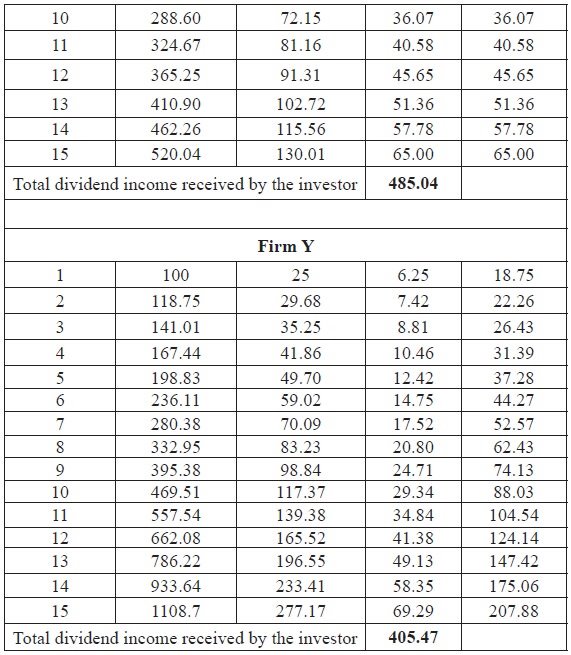
If you look at the returns* to the investors of firms X and Y at the end of 15 years, the following position will emerge on Rs.100 invested in each firm
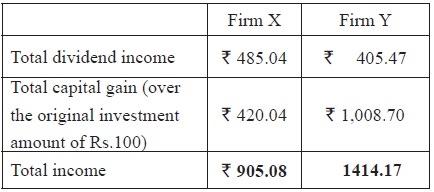
overlooking the interest on the dividend received by way of cash.
For low-dividend companies, the amount of dividends actually exceeds that of high-dividend companies since the 14th year.
Looking at the market value, companies that pay less will have higher market stock prices because of their higher revenue growth.
The uncertainties surrounding the future profitability of the company will make certain investors prefer the certainty of current dividends. Investors prefer "large" dividends. Investors do not like to produce "homemade" dividends, but companies prefer to distribute them directly.
Capital gains tax is deferred until the actual sale of shares. This creates a timing option. Capital gains take precedence over dividends, everything else is the same. Therefore, high dividend yield stocks should be sold at a discounted price to generate a higher pre-tax rate of return. Certain institutional investors do not pay taxes.
Dividends are taxed heavier than capital gains, so high-dividend companies should have higher pre-tax returns. Empirical results are mixed-recently, the evidence is in close agreement with dividend neutrality.
2. Retained earnings ratio
If x is the payment ratio, then the retained earnings ratio is 100 minus x. In other words, the retained earnings ratio is the opposite of the payment rate. As we saw above, low payout (and therefore high retention) policies can generate higher dividend announcements to increase profit growth (thus higher stock prices in the secondary market and huge capital gains).
3. Capital gains
Investors in growing companies realize their returns primarily in the form of capital gains. Generally, these growing companies increase their revenue year by year, but their payment ratio may not be very high. Therefore, their retention rate is high. Investors in such companies will earn capital gains in later years. However, the impact of dividend policy (high or low dividends when retained earnings are low or high) is not very simple. Such capital gains will bring distant futures, and therefore many investors may consider them uncertain.
4. Dividend yield
Dividend yield is the dividend per share divided by the market value per share. Dividend yields provide shareholder interests related to the market value of a stock.
Key takeaways:
- Payment ratio is defined as a dividend as a percentage of revenue. It is an important concept of dividend policy.
- The uncertainties surrounding the future profitability of the company will make certain investors prefer the certainty of current dividends.
- Investors in growing companies realize their returns primarily in the form of capital gains.
- Dividend yield is the dividend per share divided by the market value per share.
Sources of long-term financing
Long term funds are required for purchase of fixed/permanent assets of an organisation. Some of the popular long term sources of funds are-
The main sources of long term finance are as follows:
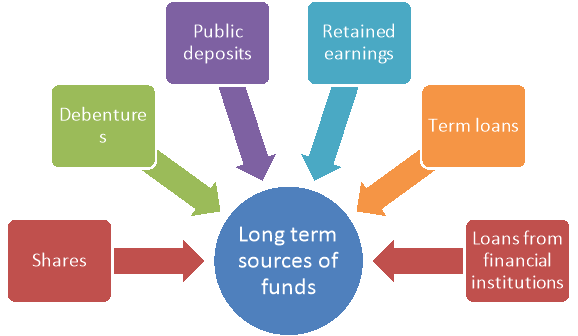
Figure: Sources of long term funds
- Shares:
These are issued to the general public. These may be of two types: (i) Equity and (ii) Preference. The holders of shares are the owners of the business.
2. Debentures:
These are also issued to the general public. The holders of debentures are the creditors of the company.
3. Public Deposits:
General public also like to deposit their savings with a popular and well-established company which can pay interest periodically and pay-back the deposit when due.
4. Retained earnings:
The company may not distribute the whole of its profits among its shareholders. It may retain a part of the profits and utilize it as capital.
5. Term loans from banks:
Many industrial development banks, cooperative banks and commercial banks grant medium term loans for a period of three to five years.
6. Loan from financial institutions:
There are many specialised financial institutions established by the Central and State governments which give long term loans at reasonable rate of interest. Some of these institutions are: Industrial Finance Corporation of India (IFCI), Industrial Development Bank of India (IDBI), Industrial Credit and Investment Corporation of India (ICICI), Unit Trust of India (UTI), State Finance Corporations etc. These sources of long term finance will be discussed in the next lesson.

Sources of short-term finance
Short-term financing is aimed to meet the demand of current assets and pay the current liabilities of the organization. In other words, it helps in minimizing the gap between current assets and current liabilities. There are different means to raise capital from the market for small duration. Various agencies, such as commercial banks, co-operative banks, financial institutions, and NABARD provide the financial assistance to organizations.
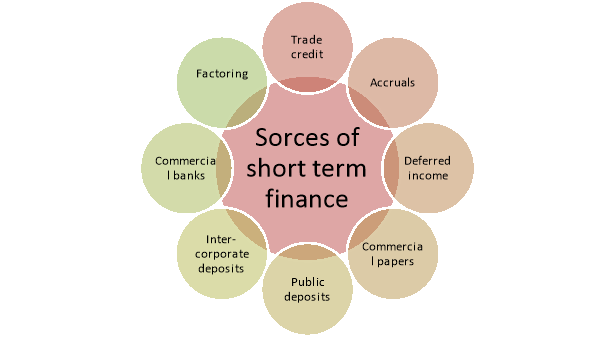
Figure: Sources of short term finance
1. Trade Credit:
Trade credit refers to the credit extended by the supplier of goods or services to his/her customer in the normal course of business. It occupies a very important position in short-term financing due to the competition. Almost all the traders and manufacturers are required to extend credit facility (a portion), without which there is no business. Trade credit is a spontaneous source of finance that arises in the normal business transactions without specific negotiation, (automatic source of finance).
2. Accruals:
Accrued expenses are those expenses which the company owes to the other, but not yet due and not yet paid the amount. Accruals represent a liability that a firm has to pay for the services or goods, it has received. It is spontaneous and interest-free source of financing. Salaries and wages, interest and taxes are the major constituents of accruals. Salaries and wages are usually paid on monthly and weekly base, respectively. The amounts of salaries and wages are owed but not yet paid and shown them as accrued salaries and wages on the balance sheet at the end of the financial year. The longer the time lag in–payment of these expenses, the greater is the amount of funds provided by the employees. Similarly, interest and tax are accruals, as source of short-term finance. Tax will be paid on earnings.
3. Deferred Income:
Deferred income is income received in advance by the firm for supply of goods or services in future period. This income increases the firm’s liquidity and constitutes an important source of short-term finance. These payments are not showed as revenue till the supply of goods or services, but showed in the balance sheet as income received in advance.
Advance payment can be demanded by firms which are having monopoly power, great demand for its products and services and if the firm is manufacturing a special product on a special order.
4. Commercial Papers (CPs):
Commercial paper represents a short-term unsecured promissory note issued by firms that have a fairly high credit (standing) rating. It was first introduced in the USA and it is an important money market instrument. In India, Reserve Bank of India introduced CP on the recommendations of the Vaghul Working Group on Money Market. CP is a source of short-term finance to only large firms with sound financial position.
5. Public Deposits:
Public deposits or term deposits are in the nature of unsecured deposits, are solicited by the firms (both large and small) from general public primarily for the purpose of financing their working capital requirements.
6. Inter-Corporate Deposits (ICDs):
A deposit made by one firm with another firm is known as Inter-Corporate Deposit (ICD). Generally, these deposits are made for a period up to six months.
Such deposits may be of three types:
(a) Call Deposits:
These deposits are those expected to be payable on call/on just one day notice. But, in actual practice, the lender has to wait for at least 2 or 3 days to get back the amount. Inter-corporate deposits generally have 12 per cent interest per annum.
(b) Three Months Deposits:
These deposits are more popular among companies for investing the surplus funds. The borrower takes this type of deposits for meeting short-term cash inadequacy. The interest rate on these types of deposits is around 14 per cent per annum.
(c) Six months Deposits:
Inter-corporate deposits are made for a maximum period of six months. These types of deposits are usually given to ‘A’ category borrowers only and they carry an interest rate of around 16 per cent per annum.
7. Commercial Banks:
Commercial banks are the major source of working capital finance to industries and commerce. Granting loan to business is one of their primary functions. Getting bank loan is not an easy task since the lending bank may ask a number of questions about the prospective borrower’s financial position and its plans for the future.
At the same time the bank will want to monitor borrower’s business progress. But there is a good side to this that is borrower’s share price tends to rise, because investor knows that convincing banks is very difficult. The different types or forms of loans are:
(i) Loans,
(ii) Overdrafts,
(iii) Cash credits,
(iv) Purchasing or discounting of bills and
(v) Letter of Credit.
8. Factoring:
Factoring is one of the sources of working capital. Banks have been given more freedom of borrowing and lending both internally and externally and facilitated the free functioning in lending and investment operations. From 1994, banks are allowed to enter directly leasing, hire purchasing and factoring services, instead through their subsidiaries. In other words, banks are free to enter or exit in any field depending on their profitability, but subject to some RBI guidelines. Banks provide working capital finance through financing receivables, which is known as “factoring”. A “Factor” is a financial institution, which renders services relating to the management and financing of sundry debtors that arises from credit sales.
Key takeaways:
- Long term funds are required for purchase of fixed/permanent assets of an organisation.
- General public also like to deposit their savings with a popular and well-established company which can pay interest periodically and pay-back the deposit when due.
- Many industrial development banks, cooperative banks and commercial banks grant medium term loans for a period of three to five years.
- Short-term financing is aimed to meet the demand of current assets and pay the current liabilities of the organization.
- Trade credit refers to the credit extended by the supplier of goods or services to his/her customer in the normal course of business.
- Accrued expenses are those expenses which the company owes to the other, but not yet due and not yet paid the amount.
- Deferred income is income received in advance by the firm for supply of goods or services in future period.
- Commercial paper represents a short-term unsecured promissory note issued by firms that have a fairly high credit (standing) rating.
- A deposit made by one firm with another firm is known as Inter-Corporate Deposit (ICD). Generally, these deposits are made for a period up to six months.
- Inter-corporate deposits are made for a maximum period of six months.
- Commercial banks are the major source of working capital finance to industries and commerce.
- Factoring is one of the sources of working capital.
The term Working Capital also called gross working capital refers to the firm’s aggregate of current assets and current assets are these assets which can be convertible into cash within an accounting period, generally a year. Accounting Standards Board, The Institute of Chartered Accountants of India defines, “Working capital means the funds available for day-to-day operations of an enterprise. It also represents the excess of current assets over current liabilities including short-term loans.”

Nature
Nature of Working Capital
Working capital is works as breath of the company without which an organisation cannot survive. Some of the features of working capital are-
- It is of two types- gross working capital and net working capital.
- It is permanent and temporary nature. Permanent working capital is needed for long term and short term working capital is needed for short term.
- It is used for purchase of raw materials, payment of wages and expenses.
- It changes form constantly to keep the wheels of business moving.
- Working capital enhances liquidity, solvency, creditworthiness and reputation of the enterprise.
- It generates the elements of cost namely: Materials, wages and expenses.
- It enables the enterprise to avail the cash discount facilities offered by its suppliers.
Significance:
The following is the importance of working capital.
- Liquidity Management: Proper analysis of costs paid or incurred in the near future allows a company's finance team to easily plan funds accordingly.
- Cash shortages: Improperly prepared plans for daily expenses can cause liquidity problems for businesses. They have to postpone or arrange funding from several other sources that give the company a bad impression at the party.
- Helps you make decisions: By properly analyzing the funding requirements of your day-to-day operations, your finance team can better manage your funds and determine the available funds and their availability accordingly.
- Add Business Value: Management manages the necessary funds on a daily basis to help authorized personnel pay all outstanding payments in a timely manner, adding value to the market or strengthening goodwill. Bring.
- Assistance in Cash Crunch Situations: Proper management of liquid funds allows organizations to pay their daily costs in a timely manner without affecting the crisis or cash crunch situation.
- Perfect Investment Planning: You can properly manage your funds or working capital, select or plan your investment accordingly, and invest your funds to maximize your return on availability.
- Helps to make short-term profits: It is sometimes seen that companies hold large amounts of working capital that far exceeds the level of working capital required. Therefore, by properly preparing the necessary working capital, these additional funds can be invested in a short period of time to create value in the profits of the company.
- Strengthening the work culture of the entity: Timely payment of daily expenses, mainly focused on employee salaries, creates a good environment and a kind of motivation among employees, works harder and works better strengthen the environment.
- Improve Business Credit: When a company properly plans working capital requirements, timely payments to vendors and other creditors can improve credit and when and when needed. You will be able to easily raise funds.
- Act as a guarantor for another company: If a company creates such a good image in the market, the business can also assist other companies and easily make business profits and contracts.
- Good reputation of an entity: An easy way to create a good reputation in the market. This makes it easy for an organization or entity to sign a contract to achieve a good image and a commitment on time. Today, everyone wants to trade and trade with such parties who have a good market reputation and creditworthiness due to increased fraud and manipulation.
Determinants of working capital
Working capital determinant
Financial management has no fixed formulas or rules for determining working capital requirements in a business. There are many factors that can be a determinant of an organization's working capital. In addition to this, the importance of factors also changes over time for the enterprise. It is very important for a company to perform a proper analysis to find out the factors that influence working capital requirements.
The determinants of a company's working capital are:
1. The nature of the business
The working capital requirements of an organization are also influenced by the nature of the business. For example, trading companies and financial companies do not need a lot of fixed assets. However, they are investing huge working capital to carry out the day-to-day operations of their business. Similarly, retailers and department stores need to own large amounts of merchandise, which requires a large amount of working capital.
Utilities, on the other hand, need more fixed assets. Therefore, the investment in working capital is relatively low compared to other companies. However, manufacturing companies need both, so they are somewhere between trading companies and utilities.
2. Technology and manufacturing policy
The manufacturing process involves procuring raw materials, using raw materials, and converting them into finished products. Therefore, as long as the manufacturing cycle continues, the need for working capital by the organization will increase. However, adding technology to the manufacturing cycle shortens the manufacturing process and thus shortens the conversion period from raw materials to finished products. This reduces working capital requirements. Therefore, it is one of the most important decisions that a company needs to decide whether to add technology to its production process.
3. Credit policy
Credit policy is another important determinant of working capital. If a company adopts a liberal credit policy, it means giving credit to the customer without looking at the customer's creditworthiness. This can delay payments from customers. The collection period will be longer. If the company cannot collect the payment, it can also result in bad debts. Therefore, it is very important for a company to design a credit policy that confirms the customer's creditworthiness, reduces the number of procedures, and grants the customer credit.
4. Market and demand conditions
Market demand also plays an important role in determining a company's working capital. For example, low demand during the lean season means that companies do not need more production, which requires less working capital. However, demand will increase during peak seasons. This allows for more production. More production leads to an increased need for working capital.
5. Change price level
Price changes also affect working capital. For example, as the price of raw materials rises, more cash is needed to purchase the raw materials, which requires more working capital. However, companies that raise the price of their products as prices rise do not have to face this problem.
6. Operational efficiency
Operational efficiency refers to the optimal use of resources by a company with minimal spending. Companies need to manage operating costs and strive to make efficient use of fixed and current assets so that they can achieve operational efficiency. This will speed up the cash conversion cycle and improve working capital use.
7. Availability of credits from suppliers
The company's working capital requirements are also influenced by the credit terms provided by the supplier. If the suppliers provide credit to the company on free terms, they need less working capital and vice versa. However, if the supplier does not have credit, the company can borrow money from the bank.
Case Study:
A Case Study on Working Capital Management of Bajaj Auto Ltd.
Bajaj Auto Ltd is a flagship of Bajaj Group which is amongst the top 10 business houses in India. Bajaj Auto is the world's third-largest manufacturer of motorcycles and the second-largest in India It is the world’s largest three-wheeler manufacturer.
Bajaj Auto came into existence on 29 November 1945 as M/s Bachraj Trading Corporation Private Limited It started off by selling imported two- and three-wheelers in India. In 1959, it obtained a license to manufacture two-wheelers and three-wheelers and it became a public limited company in 1960. In 1970, it rolled out its 100,000th vehicle. In 1977, it sold 100,000 vehicles in a financial year. In 1985, it started producing at Waluj near Aurangabad.
It was founded by Jamnalal Bajaj in Rajasthan in the 1930s. It is based in Pune,Mumbai, with plants in Chakan (Pune), Waluj (near Aurangabad) and Pantnagar in Uttarakhand. The oldest plant at Akurdi (Pune) now houses the R & D centre 'Ahead'.
On 31 March 2013, its market capitalization was INR 520 billion (US$9.57 billion), making it India's 23rd largest publicly traded company by market value. With the launch of motorcycles in 1986, the company has changed its image from a scooter manufacturer to a two-wheeler manufacturer.
According to the authors of Globality: Competing with Everyone from Everywhere for Everything, Bajaj has operations in 50 countries by creating a line of bikes targeted to the preferences of entry-level buyers.
Bajaj Auto Ltd., incorporated in the year 2007, is a Large Cap company (having a market cap of Rs 58,491.2 Cr.) operating in Auto sector.
Bajaj Auto Ltd. Key Products/Revenue Segments include Automobile - Vehicles which contributed Rs 18800.53 Cr to Sales Value (88.85% of Total Sales), Auto Spare Parts (Trading) which contributed Rs 1659.97 Cr to Sales Value (7.84% of Total Sales), Export Incentives which contributed Rs 335.94 Cr to Sales Value (1.58% of Total Sales), Auto Spare Parts which contributed Rs 241.97 Cr to Sales Value (1.14% of Total Sales), Scrap which contributed Rs 54.82 Cr to Sales Value (0.25% of Total Sales), Royalty Income which contributed Rs 40.59 Cr to Sales Value (0.19% of Total Sales), Vehicles - Trading Items which contributed Rs 24.57 Cr to Sales Value (0.11% of Total Sales), Other Operating Revenue which contributed Rs 0.52 Cr to Sales Value (0.00% of Total Sales), for the year ending 31-Mar-2014.
For the quarter ended 31-Dec-2014, the company has reported a Standalone sale of Rs. 5520.01 Cr., down -5.27% from last quarter Sales of Rs. 5826.85 Cr. And up 9.86% from last year same quarter Sales of Rs. 5024.76 Cr. Company has reported net profit after tax of Rs. 861.24 Cr. In latest quarter.
Bajaj Auto with its strong brand image and other competency features maintained dominant position in India. Year on year the company increased production size and attained economies of scale.
Working Capital
Working Capital is that which is required to operate routine business activities. It reflects the liquidity position of the company. Working capital is excess of current assets over current liabilities. Current assets include cash, bank balance, marketable securities, inventories and receivables whereas current liabilities include creditors, bills payable and provisions. Working capital has great influence on profitability and solvency. As we increase the liquidity the profitability will be effected and if we decrease it the solvency will be effected.
Working Capital of Bajaj Auto Ltd. Is given below:
Current Assets | Mar’2014 | Mar’2013 | Mar’2012 | Mar’2011 | Mar’2010 |
Inventories | 639.72 | 636.28 | 678.53 | 547.28 | 446.21 |
Sundry Debtors | 796.21 | 767.58 | 423.20 | 362.76 | 272.84 |
Cash and Bank Balance | 495.48 | 558.86 | 446.49 | 155.45 | 100.20 |
Total Current Assets | 1,931.41 | 1,962.72 | 1,548.22 | 1,065.49 | 819.25 |
Loans and Advances | 2,116.46 | 1,987.44 | 1,744.82 | 3,891.66 | 2,291.29 |
Fixed Deposits | 0.00 | 0.00 | 1,208.36 | 401.04 | 1.21 |
Total CA, Loans & Advances | 4,047.87 | 3,950.16 | 4,501.40 | 5,358.19 | 3,111.75 |
Current Liabilities | 3,108.15 | 2,762.93 | 2,925.53 | 2,624.35 | 2,218.06 |
Provisions | 1,973.69 | 1,742.47 | 2,174.89 | 3,925.72 | 2,248.72 |
Total CL & Provisions | 5,081.84 | 4,505.40 | 5,100.42 | 6,550.07 | 4,466.78 |
Net Current Assets | -1,033.97 | -555.24 | -599.02 | -1,191.88 | -1,355.03 |
Key takeaways:
- The term Working Capital also called gross working capital refers to the firm’s aggregate of current assets and current assets are these assets which can be convertible into cash within an accounting period, generally a year.
- Working capital is works as breath of the company without which an organisation cannot survive.
- Proper analysis of costs paid or incurred in the near future allows a company's finance team to easily plan funds accordingly.
- Proper management of liquid funds allows organizations to pay their daily costs in a timely manner without affecting the crisis or cash crunch situation.
- Timely payment of daily expenses, mainly focused on employee salaries, creates a good environment and a kind of motivation among employees, works harder and works better strengthen the environment.
- An easy way to create a good reputation in the market. This makes it easy for an organization or entity to sign a contract to achieve a good image and a commitment on time.
- Financial management has no fixed formulas or rules for determining working capital requirements in a business.
- The working capital requirements of an organization are also influenced by the nature of the business.
- The manufacturing process involves procuring raw materials, using raw materials, and converting them into finished products.
- Credit policy is another important determinant of working capital.
- Market demand also plays an important role in determining a company's working capital.
- Price changes also affect working capital. For example, as the price of raw materials rises, more cash is needed to purchase the raw materials, which requires more working capital.
- Operational efficiency refers to the optimal use of resources by a company with minimal spending.
- The company's working capital requirements are also influenced by the credit terms provided by the supplier.
Reference:
1. Avadhani, V.A. : Finacial System
2. Bhalla, V.K. : Modern Working Capital Management
3. Brigham, E.F.Gapenski, L.C. : Financial Management- Theory and Practice & Ehrhardt, M.C